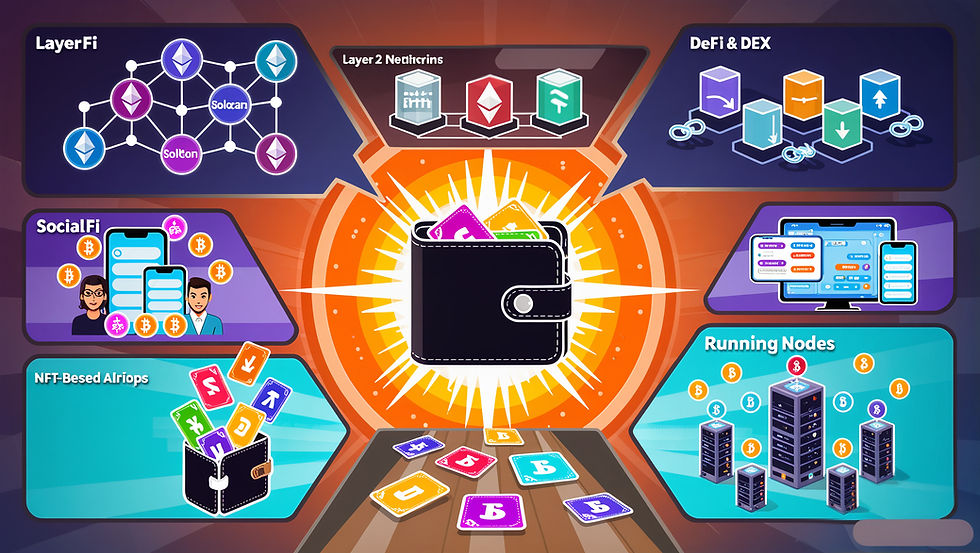Proven Strategies for Hunting Retroactive Airdrops Effectively
- rachelbeautybar

- Aug 2
- 3 min read
Airdrops and retroactive rewards have changed the game for many crypto investors, turning small portfolios into life-changing gains. As more users rush into retroactive airdrop strategies, the question is: how can you prepare to secure the biggest rewards while minimizing risk?
How to Approach Airdrops and Retroactive Rewards

To farm airdrops efficiently without wasting time or capital, you need to focus on three key factors:
Target projects with strong funding and reputable VCs. Use platforms like Cryptorank to find projects raising significant capital.
Prioritize blockchain infrastructure projects over simple DeFi apps.
Focus on ecosystems with strong liquidity flow such as Ethereum, Solana, and upcoming L1s without tokens.
Avoid overcrowded airdrops like LayerZero or zkSync unless you have large capital, as user competition reduces per-wallet rewards.
💡 Example: Jito rewarded early users with an average of $17,800 per wallet, proving that smaller, less-hyped projects can deliver huge gains.
Avoiding Sybil Flags When Farming
Many projects are cracking down on Sybil activity—users creating multiple fake wallets to claim airdrops. To avoid being disqualified:
Use anti-detect browsers (GoLogin, MultiLogin, AdsPower) to rotate IPs.
Avoid funding multiple wallets from the same source; use bridges like Bungee Exchange to mix flows.
Don’t transfer assets back and forth between wallets.
Create social accounts linked to wallets to appear authentic.
Leave a small balance after farming; some projects like Starknet required 0.005 ETH to qualify.
Spread interactions over time instead of doing everything in one day.
Use all project features (swap, bridge, staking) like a real user.
Top Ecosystems for Retroactive Airdrop Strategies

Layer 1 Blockchains
Monad: Raised $225M. Run nodes and interact with early apps.
Ronin: Staking RONIN rewarded users with PIXEL & YGG airdrops; future rewards likely.
TON: Join The Open League activities like minting and liquidity provision.
Ethereum Restaking: Platforms like Swell, Puffer, Karak, and Kelp are hot. Stake at least $500 per protocol to increase odds.
Solana: Engage with projects like Meteora and Backpack.
Cosmos: Chain-staking strategies (ATOM → TIA → DYM → OM) show consistent airdrop potential.
Layer 2 Networks
Base, Linea, Scroll, Blast, Mode: All high TVL and early-stage.
Ancient8: Early adopters received HAIRY memecoin; active users may get A8 token.
Zora: Mint NFTs, especially those by Zora or Base Foundation.
SocialFi
Farcaster & Lens Protocol: Simple weekly interactions (posting, liking) can secure future rewards.
DeFi & DEX Platforms
Use DEXes without tokens: Bungee Exchange, MetaMask Portfolio, Zapper, Zerion, Slingshot, Superfluid, Layer3, etc.
NFT-Based Airdrops
Holding Mad Lads on Solana or Yuga Labs NFTs (MAYC, Otherside) has delivered $10K+ in cumulative rewards.
Running Nodes for Retroactive Airdrops
Running nodes is one of the most reliable retroactive airdrop strategies.
Use VPS providers like Contabo.
Check Nodes Guru for eligible projects.
Projects like Aptos rewarded both testnet node runners and form submitters.
The Post-Airdrop Phase: What Happens Next?
NFT Prices: Typically drop after snapshot (example: Tensorians, Mavia Land).
Token Prices: Some pump (Celestia from $2 → $18), others dump (ParaSwap). Always analyze market cap and tokenomics before holding long-term.
Final Thoughts
With more projects launching every month, retroactive airdrop strategies are becoming increasingly competitive. The key is to act early, diversify, and engage with projects like a real user. Allocate time and capital wisely to avoid burnout and maximize ROI.
Register by the links below to get cashback fees up to 70%:
Comments